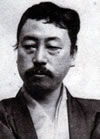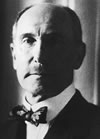
BH. John Gould Fletcher
5. ‘The Secret of Far Eastern Painting’. Dial 62 (January 1917): 3-7.
One wishes Fletcher’s poetry were as interesting as his criticism. This work is an insightful comparative analysis of the strengths of European and East-Asian art, which posits finally the ‘moral superiority’ of the latter. The Western artist may ‘spen[d] his life trying to drive home moral teachings’, and may be ‘richer in color, more diverse in range, more skilled in . . . form, [and] capable of bolder conceptions’, but ‘all this avails him nothing’ when compared to the ‘dignity with which the Oriental has invested a spray of simple bamboo’. This ‘dignity’, Fletcher argues, is ‘not in the plant itself’ but ‘in the painter’s eye, mind, and hand’, and these work together ‘to render it in line, tone, and feeling’. The argument is essentially a more developed version of that set forth in the preface to Goblins and Pagodas (4), and is open to the same criticism, at least from the Zen Buddhist perspective Fletcher espouses in both works. That the ‘dignity’ is ‘not in the plant itself’ is a misunderstanding from the perspective of Zen. Still, the work allows itself more time to develop adjunct lines of argument than the earlier preface, and while not the last word on comparative art history or aesthetic theory it is nonetheless well-observed and well-reasoned, the work of a serious student of Chinese and Japanese art history and theory. Fletcher draws some of his reasoning from Fenollosa (especially D10c) and Okakura (see D16) and derives parts of the argument from aesthetic concepts related to sumie, kakemono, and makimono. Includes passing reference to Charles Lang Freer (Ap), John La Farge (Ap), and Whistler (Ap). Reprinted in 21.








